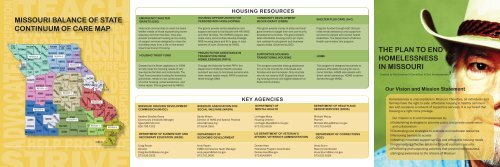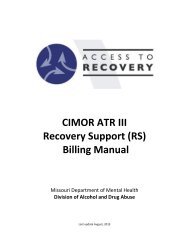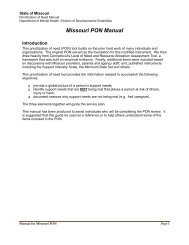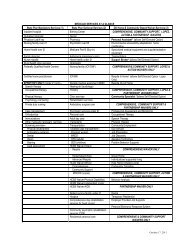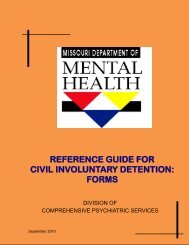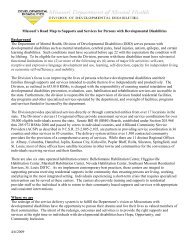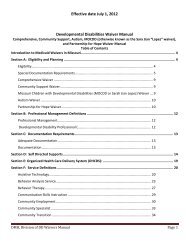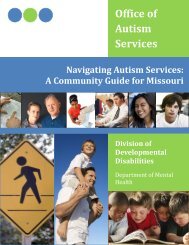10 year plan web version.indd - Missouri Department of Mental Health
10 year plan web version.indd - Missouri Department of Mental Health
10 year plan web version.indd - Missouri Department of Mental Health
- No tags were found...
You also want an ePaper? Increase the reach of your titles
YUMPU automatically turns print PDFs into web optimized ePapers that Google loves.
INVESTIGATEADVOCATE PARTICIPATIONITEACHASSISTT N EMISSOURI BALANCE OF STATECONTINUUM OF CARE MAPDEVELOPLEARNREGION 3REGION 4REGION <strong>10</strong>REGION 9IPREGION 5REGION 2REGION 8REGION 1REGION 7REGION 6RESPONSIBLEEMERGENCY SHELTERGRANTS (ESG)Help local communities to meet the basicshelter needs <strong>of</strong> those experiencing homelessnessand their families. They alsoprovide transitional housing and a variety<strong>of</strong> support services designed to move thehomeless away from a life on the streettoward permanent housing.HOUSING TRUST FUNDCreated by the State Legislature in 1994to help meet the housing needs <strong>of</strong> verylow-income families and individuals. TheTrust Fund provides funding for homelessprevention, rehab or new construction<strong>of</strong> rental housing, rental assistance, andhome repair. This is governed by MHDC.MISSOURI HOUSING DEVELOPMENTCOMMISSION (MHDC)Heather Bradley-GearyCommunity Initiatives Managerhgeary@mhdc.com816.759.7201DEPARTMENT OF ELEMENTARY ANDSECONDARY EDUCATION (DESE)Craig RectorDirectorCraig.Rector@dese.mo.gov573.526.3232HOUSING OPPORTUNITIES FORPERSONS WITH AIDS (HOPWA)The grants provide rental assistance andsupport services to individuals with HIV/AIDSand their families. The HOPWA program alsohelps many communities develop strategicAIDS housing <strong>plan</strong>s and fi ll in gaps in localsystems <strong>of</strong> care. Governed by DHSS.PROJECTS FOR ASSISTANCE INTRANSISTION FROMHOMELESSNESS (PATH)Through the federally funded PATH, the<strong>Department</strong> <strong>of</strong> <strong>Mental</strong> <strong>Health</strong> providesoutreach services to homeless persons whohave mental health needs. PATH is administeredthrough DMH.MISSOURI ASSOCIATION FORSOCIAL WELFARE (MASW)Sandy WilsonDirector <strong>of</strong> HMIS and Special Projectswilson@masw.org573.634.2901DEPARTMENT OFECONOMIC DEVELOPMENTAndy PapenCDBG Compliance Team Managerandy.papen@ded.mo.gov573.751.3600HOUSING RESOURCESCOMMUNITY DEVELOPMENTBLOCK GRANT (CDBG)This grant awards money to state and localgovernments to target their own communitydevelopment priorities. The grant rehabilitatesaffordable housing and is an importantcatalyst for job growth and businessopportunities. Governed by DED.SUPPORTIVE HOUSING/TRANSITIONAL HOUSINGThis program provides leasing assistancefor up to 24 months for individuals andfamilies who are homeless. Only countieswho do not receive HUD Supportive Housingfunding directly are eligible (Balance <strong>of</strong>State Communities).KEY AGENCIESDEPARTMENT OFMENTAL HEALTHLiz Hagar-MaceHousing DirectorLiz.Hagar-Mace@dmh.mo.gov573.522.6519US DEPARTMENT OF VETERAN’SAFFAIRS, VETERAN’S ADMINISTRATIONDenise HeetHomeless Program CoordinatorDenise.Heet@va.gov573.814.6654SHELTER PLUS CARE (S+C)Program funded through HUD that providesrental assistance and supportiveservices for people with mental healthdisabilities. The <strong>Department</strong> <strong>of</strong> <strong>Mental</strong><strong>Health</strong> administers this program.HOMEThis program is designed exclusively toproduce affordable housing for low-incomefamilies. HOME also assists withdirect rental assistance. HOME is administeredthrough MHDC.DEPARTMENT OF HEALTH ANDSENIOR SERVICES (DHSS)Michael McLayPlannerMichael.McLay@dhss.mo.gov573.751.6439DEPARTMENT OF CORRECTIONS(DOC)Vevia SturmReentry CoordinatorVevia.Sturm@doc.mo.gov573.522.6128THE PLAN TO ENDHOMELESSNESSIN MISSOURICreated by the Governor’s Committee to End HomelessnessOur Vision and Mission StatementHomelessness is unacceptable in <strong>Missouri</strong>. Therefore, all individuals andfamilies have the right to safe, affordable housing in healthy communitieswith access to a network <strong>of</strong> supportive services. It is our belief thathousing is a right not a privilege.Our mission is to end homelessness by:Establishing strategies to promote public and private coordinationand collaborationDeveloping new strategies to evaluate and reallocate resourcesRemoving barriers to accessMeeting immediate support service and affordable housing needsImplementing effective solutions to build economic securityPromoting and supporting activities that prevent homelessnessBringing awareness to the citizens <strong>of</strong> <strong>Missouri</strong>
HISTORY AND OVERVIEWGOAL 6: GOAL 5: GOAL 4: GOAL 3: GOAL 2: GOAL 1:GOALSGather and maintain information about homelessness and resources within the state.Provide affordable housing and supportive services for people who are homeless.Encourage commitment from state leadership to use mainstream resources to endhomelessness.Facilitate local <strong>plan</strong>ning collaboratives to address community housing and homelessservice delivery strategies.Take the necessary actions to fully utilize federal, state, and other funds available toaddress the needs <strong>of</strong> those experiencing chronic homlessness.Take the necessary actions to fully utilize federal, state, and other funds available toend generational homelessness among families.INITIAL STEPSThese steps were created in the early stages <strong>of</strong> the <strong>10</strong> Year Plan and have since been completed. The Committee was directed ,andcompleted the following tasks on June 30, 2004:The Governor’s Committee to End Homelessness was composed <strong>of</strong> representatives from state departments and other homeless coordination serviceagencies (current member list included).The Governor’s Committee to End Homelessness pursued all available federal funding to support the implementation <strong>of</strong> the <strong>Missouri</strong> Action Plan.Reviewed and recommended measures to improve access to state administered Mainstream Service Programs (Medicaid, TANF, SSI, CHIP, WorkforceInvestment Act, Food Stamps, and Veteran’s <strong>Health</strong> Care and Benefi ts) by homeless individuals and families.Reviewed and recommended measures to establish state policies that affect housing for families and individuals such as affordable housing, workforcehousing, institutional discharge <strong>plan</strong>ning, and reentry programs.Reviewed the State <strong>of</strong> <strong>Missouri</strong> Homeless Action Plan to End Homelessness annually and presented recommendations on the implementation strategyto state and federal policy makers.Established the Homeless <strong>Missouri</strong>ans Information System (HMIS) to collaborate data.Governor John Ashcr<strong>of</strong>t established the Governor’s Committeeto End Homelessness in 1987. The Governor’s Committee toEnd Homelessness has met continuously since its establishment.In the early <strong>year</strong>s, the committee met quarterly toexchange information about programs and services, sharefunding opportunities, and discuss homeless needs in thestate <strong>of</strong> <strong>Missouri</strong>.In 1994, the committee began to meet monthly and take on amore active role in <strong>plan</strong>ning and developing services for homeless <strong>Missouri</strong>ans. Thoseactivities include coordinating and facilitating a Balance <strong>of</strong> State Continuum <strong>of</strong> CarePlan, developing a <strong>plan</strong> to End Homelessness and providing technical assistance tonon-pr<strong>of</strong>i t agencies in accessing homeless assistance funds. From January throughNovember 2003 Members <strong>of</strong> the Committee worked with the Governor’s Offi ce to gain<strong>of</strong>fi cial recognition. On November 7, 2003, the Governor’s Committee to End Homelessreceived that recognition and was <strong>of</strong>fi cially established with the Offi ce <strong>of</strong> Boards andCommissions.The Governor’s Committee to End Homelessness has three primary responsibilities. Firstis facilitating the Balance <strong>of</strong> State Continuum <strong>of</strong> Care process. The second function <strong>of</strong>the Governor’s Committee to End Homelessness is to raise awareness <strong>of</strong> homeless issuesin <strong>Missouri</strong>. Third, the Committee maintains a list <strong>of</strong> resources and shares resourcesthroughout the state. In addition, as part <strong>of</strong> our HUD requirements, the Committeeensures there is a valid Homeless <strong>Missouri</strong>ans Information System (HMIS) and conductsRegional Housing Team Meetings on a quarterly basis.GOVERNOR’S COMMITTEE TO END HOMELESSNESS MEMBER LISTGOAL 7:GOAL 8:GOAL 9:Take the necessary actions to fully utilize federal, state, and other funds available toend homelessness among veterans and their families.Take the necessary actions to fully utilize federal, state, and other funds available todevelop housing for ex-<strong>of</strong>fenders.Assure that various state discharge policies do not increase the number <strong>of</strong> formerlyinstitutionalized individuals that become homeless.“Homelessness isunacceptable in <strong>Missouri</strong>.”These are steps the Governor’s Committee to End Homelessness intends to accomplish in the coming <strong>year</strong>s.Support collaborative efforts <strong>of</strong> shared informationbetween all continua in the state <strong>of</strong><strong>Missouri</strong>Reduce the stigma on homelessness by raisingawareness about homelessnessIncrease housing stock and affordable housingCreate a relationship between the ConsolidatedPlan, the <strong>10</strong> Year Plan and the Balance <strong>of</strong> StateContinuum <strong>of</strong> Care grant administered by HUDGain support for ex-<strong>of</strong>fenders being releasedand increase reentry programsImplement Project Homeless ConnectIncrease housing optionsIncrease subsidiesCollaborate with State leadership in the adoption<strong>of</strong> strategies, allocation <strong>of</strong> resources, and implementation<strong>of</strong> the recommendations <strong>of</strong> this reportNEXT STEPSDenise Heet, GCEH ChairSandy Wilson, GCEH Vice ChairHeather Bradley-Geary, GCEH SecretaryLiz Hagar-Mace, GCEH HistorianJames Figueroa-Robnett, Jr.Craig RectorCarolyn StemmonsJeannie Chaffi nJennifer CarterMichael McLayVevia SturmRandy Griffi thAntoinette TriplettDana McAuliffeCynthia LarcomMichelle GarandRandy SharpDan ClarkGreg VogelweidDoilnella WilliamsMyra CallahanMajor George WindhamTyrone J. FlowersGerry HodgeVacant Slot: Dept. <strong>of</strong> Social Services, Division <strong>of</strong>Youth ServicesVacant Slot: Dept. <strong>of</strong> Social Services, MedicaidProgram RepresentativeVacant Slot: Workforce DevelopmentVacant Slot: Social Security Administration


